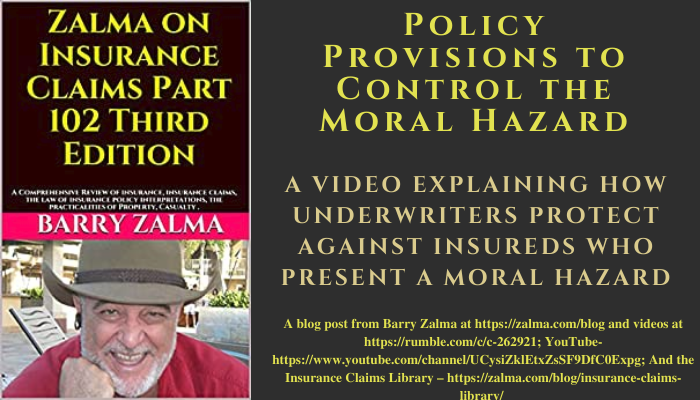-
News Feed
- EXPLORE
-
Pages
-
Groups
-
Events
-
Blogs
-
Marketplace
-
Offers
-
Jobs
-
Developers
Policy Provisions to Control Moral Hazard

A Video Explaining How Underwriters Protect Against Insureds Who Present a Moral Hazard
Read the full article at https://www.linkedin.com/pulse/policy-provisions-control-moral-hazard-barry-zalma-esq-cfe and see the full video at https://rumble.com/vok4xs-a-video-explaining-how-underwriters-protect-against-insureds-who-present-a-.html and at https://youtu.be/zDLZmEUK2v8 and at https://zalma.com/blog plus more than 3950 posts.
Policy provisions can be used to control the risk of the moral hazard, without refusing the risk in its entirety. Built-in provisions of the policies like the “fraud and misrepresentation” conditions work to deter losses by persons with a moral hazard.
The standard fire policy, and most first party policies, provide that the entire policy is void if the applicant commits fraud in securing the insurance or if the insured willfully misrepresents or conceals any material fact or circumstance concerning insurance. If the policy is a marine policy the insured is required to volunteer material information even if not asked. With other types of insurance, the onus is on the insurer to ask the right questions. Failure to ask can compel an insurer to stay on a risk it would never have taken if it knew the truth.
Cancellation:
The insurer retains the right to cancel coverage. However, recent consumer-oriented legislation has effectively eliminated this option after a policy is in effect for 60 days except for nonpayment of premium or fraud. This legislation means that pre-risk inspection and post-loss reports are even more important to the underwriter.
Prompt Reporting of A Loss:
This requirement is designed to deprive the insured of the opportunity to organize evidence to appear honest.
Settlement of loss:
The insurer retains the right to repair the damaged property.
Exclusion or special limitations:
Certain property, like money, gold, and jewelry, may be excluded or may have special limitations placed on it to limit the insurer’s exposure to a fraudulent loss.IIncrease of Hazard:
The policy provides that no coverage exists if the insured does something to increase the hazard before the loss. For example, if a tuna fish cannery, without informing its insurer, decides to change its function to the manufacture of plastic explosives and nitroglycerine, this significant increase of hazard would not be covered.
In Dynasty, Inc. v. Princeton Insurance Co., 165 N.J. 1 (N.J. 07/24/2000), the Supreme Court of New Jersey found that an insured who unjustifiably disabled a sprinkler system so increased the hazard faced by the insurer that the fire insurance coverage was suspended. It also found that the “increase-of-hazard” clause is standard language required by statute N.J.S.A. 17:36-5.20.
© 2021 – Barry Zalma
We are 100% funded for October.
Thanks to everyone who helped out. 🥰
Xephula monthly operating expenses for 2024 - Server: $143/month - Backup Software: $6/month - Object Storage: $6/month - SMTP Service: $10/month - Stripe Processing Fees: ~$10/month - Total: $175/month
- Art
- Causes
- Crafts
- Crime
- Dance
- Drinks
- Film
- Finance
- Fitness
- Food
- Games
- Gardening
- Health
- Home
- Literature
- Music
- Networking
- Paranormal
- Other
- Politics
- History
- News
- Party
- Science
- Religion
- Shopping
- Sports
- SyFy
- Politically Incorrect
- Philosophy
- Theater
- Technology
- Wellness



